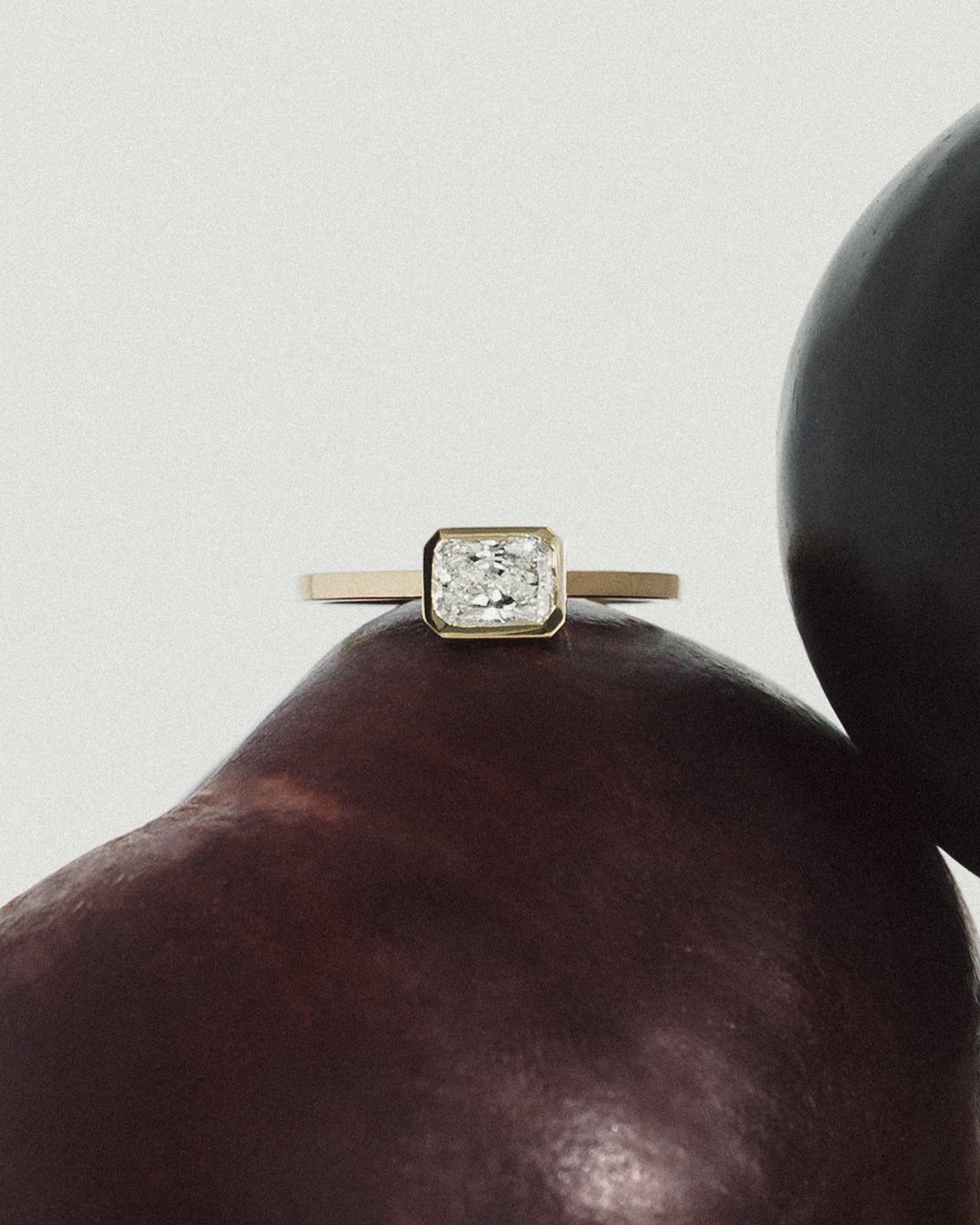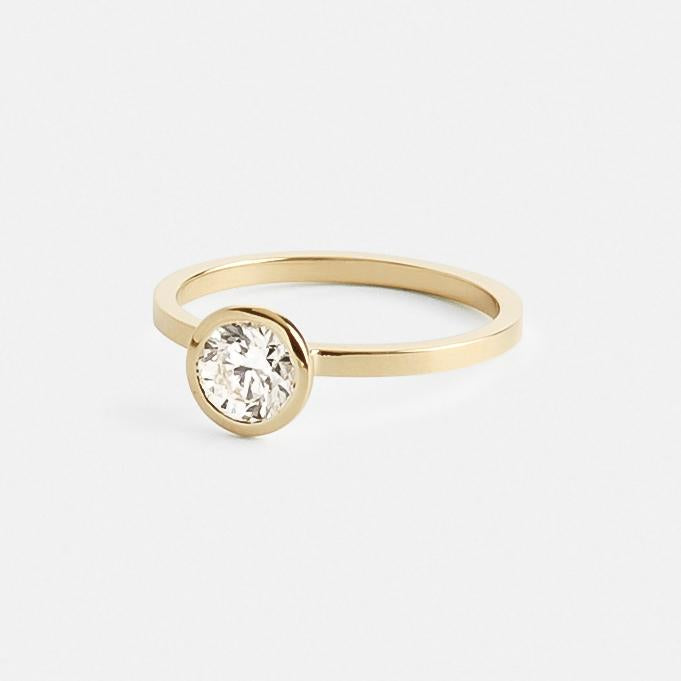Welcome to our diamond guide. Rare, precious, and everlasting, diamonds are fascinating gemological curiosities with a rich history.
At SHW, we offer ethically sourced earth-created and sustainable lab-grown diamonds. Both types are the same gemstone with identical physical, chemical, and optical properties, differing only in origin. On this page, you will find information about how both form and their four key characteristics—carat weight, color, clarity, and cut—that all signify value. With this knowledge, you’ll be able to select the diamond that suits you best with confidence and ease.
Once the lab-grown or earth-created diamond is selected, the next step is to choose the quality of the diamond and the shape of its cut. Both types of diamonds are graded by gemological institutes following exactly the same process and are cut using exactly the same standards. To help guide your process, you can learn about diamond grading and certification, the 4 C’s, diamond shapes, and more, below.
DIAMOND CUT
Gemological laboratories study a modern diamond’s cut based on how its facets interact with light, prescribing an excellent, very good, good, fair, or poor grade. Excellent and very good sparkle the most. Since this C determines the overall appearance of the modern day brilliant cut diamond, we consider it to be one of the most important. We recommend only selecting diamonds with an 'excellent' grading.
The modern round brilliant cut diamond has 57 facets, or sometimes 58 if the cutter included a culet, which is an additional facet at the bottom of the pavilion. Today, diamonds are cut with a precision up to 1/100th of a millimeter allowing the perfect balance of proportions to reveal a diamond's beauty.
The Crown
1.Table 2.Star Facet 3.Bezel Facet 4.Upper Girdle FacetThe Girdle
5.GIRDLEThe Pavillion
6.Lower Girdle Facet 7.Pavillion Facet 8.CuletHave any questions about diamond cut grading? We can help.
DIAMOND COLOR
Gemological institutes grade white diamonds based on the absence of color. Though diamonds are primarily carbon, they often include trace elements that can affect their color. The most common trace element is nitrogen, which gives off a subtle shade of yellow. The more a diamond crystal is tinted with yellow, the more common they are which decreases their value. However, diamonds that posess a vivid yellow hue past "Z" are also a rarity and increase in price.
To grade white diamond color, gemological institutes use letters of the alphabet, starting from D (colorless) all the way to Z (light yellow). For natural diamonds, truly colorless options are quite rare and therefore you will see a price jump when compared to diamonds with a lesser color grading. For lab-grown, the ability to control the environment the crystal is formed in allows for colorless diamonds to be more common where the difference in price for higher and lower grade options is less substantial. You should note that subtle hints of color are difficult to see with the naked eye. The most common color ranges are D through F and G through J.
Grading standards set by The Gemological Institute of America (GIA)
We’ll help you select a diamond color and setting metal that highlights your personal style.
DIAMOND CLARITY
From formation of the crystal to cutting and polishing, diamonds undergo a long journey, leaving an individual mark on each stone. The diamond’s internal markings are called inclusions, while surface irregularities are called blemishes. Together, they’re called clarity characteristics. Gemologists grade diamond clarity based on the absence of inclusions and blemishes. After thorough examination, they prescribe a rating from flawless (no inclusions or blemishes) to included (some clarity characteristics will be visible even with the naked eye).
The fewer inclusions and blemishes the diamond has, the more valuable it is considered to be. Nonetheless, clarity characteristics are like a natural diamond's 'birth marks' and are extraordinary gemological manifestations of its formation.
Grading standards set by The Gemological Institute of America (GIA)
DIAMOND CARAT
Diamond carat (ct) refers to a diamond’s weight. Both lab-grown and natural diamonds rise in price as they increase in carat weight. The bigger the diamond is, the more rare it is to find nature. In a laboratory, they take more time to grow.
The price for natural diamonds rises more exponentially as they increase in weight when compared to lab-grown diamonds prices.
Diamond cutters today use advanced technology to achieve the best proportions, ensuring that each diamond is cut following similar ratios. This allows them to estimate the diamond's diameter based on its carat weight. Though this is still an approximation, it can help you identify the best carat weight for your desired size.
Need a millimeter ruler? We’ll send you one.
DIAMOND SHAPE
Though round diamonds are the most popular shape, accounting for more than half sold today, there are quite a few others to consider.
Have any questions or interested in creating a custom piece with one of our settings? Let's talk.
DIAMOND CERTIFICATION
Our diamonds that weigh 0.4ct and up come with a certification from either GIA (The Gemological Institute of America) or IGI (The International Gemological Institute). Both institutes are dedicated to research and education in the fields of gemology and jewelry design. They carefully examine each diamond, issuing each one a unique number, which is inscribed on the part of the diamond known as the girdle. The diamonds' certificates include important information about each specific stone, such as its identification number and characteristics. These characteristics, known as the 4 C's, are carat weight, color, clarity, and cut.
Throughout history, diamond merchants considered the 4 C’s, but used broad, inconsistent terms. The diamonds' certificates include important information about each specific stone, such as its identification number and characteristics. These characteristics, known as the 4 C's, are carat weight, color, clarity, and cut. Each factor strongly affects a diamond’s price, so familiarity is essential when considering different options.
All diamonds set in our wedding rings are certified and carefully vetted by our in-house gemologist to meet the highest standards. Our lab-grown diamonds come with an IGI(The International Gemological Institute) certification. They are sourced from a women founded and operated diamond grower and cutter based in Surat, India. Our earth-grown diamonds come with a GIA (The Gemological Institute of America) and Canadamark certifications. They are sourced from Ekati and Diavik mines in Canada, which are well respected for their strict environmental and socio-economic policies.
If you are interested in customizing a ring from our SHW wedding collection, our GIA certified gemologist will carefully craft a list of diamonds for your selection or follow your specifications and requests.
Our settings can be customized for heirloom or pre-owned diamonds. Some setting styles might work better than others, depending on the cut of your gemstone. Please schedule a time to chat with us here or reach out via email at hello@shwjewelry.com with information about your stone and the setting designs you're considering so our jewelry designer can advise you and answer any questions you might have.
Though our SHW wedding jewelry designs are made to be enjoyed forever, sometimes unpleasant surprises happen. With this in mind, it’s best to be prepared and insured. We recommend Jeweler’s Mutual for jewelry insurance, as many of our past customers have had great experiences working with them.
Have any questions or interested in starting a conversation? Reach out.


